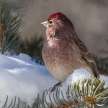
The diminutive tinamou (Crypturellus soui) is a species of tinamou. This occurs in Central and South America. Crypturellus consists of three words, either Latin, or Greek. Kruptos meaning concealed or obscured, our ears saying, and ellus saying diminutive. Crypturellus also means short, concealed tail. The tiny tinamou is one of 21 members in the most members-rich family, the tinamous family Crypturellus. All tinamous are in the Tinamidae family, and there are also palaeognaths in the larger class, a group of flightless ratites such as ostriches and emus that are more widely recognised. Unlike the ratites, however, tinamous can float but in general they are not fast fliers. The palaeognaths adapted as flight ancestors. It is a resident breeder at 2,000 m (6,600 ft) altitudes in tropical lowland forests, riverbank forests, lowland evergreen forests, secondary forests, and lowland shrublands. They often allow very good use of cleared forests and plantations, or farmed land. The tiny tinamou, like Trinidad Island, is found throughout central and southern Central and northern South America. The little tinamou is rarely seen with its dark, dense trees roaming slowly through the undergrowth. This can be found by its slow whistling calls (soft, downward whinny; also a series of single notes, the tempo increasing at the end), produced by both sexes. It consumes seeds, vegetables and other insects. The breeding season of the little tinamou extends from May to October. Its nest is a small depression of the forest-floor, often filled with several leaves at the base of a tree or dense brush. Usually, two bright, deep purple coloured eggs are laid, sometimes just one. The height of the eggs is about 41 to 32 mm. Larvae are incubated by male. The youngsters are precocious and can fly just as soon as they hatch. The little tinamou is about 22 to 24 cm long and weights 220 g. This character is a silent tinamou, mysterious and solitary. While it looks similar to other birds living on the ground, such as quail and grouse, it is entirely different to those groups. This is a dumpy bird noted for its small size and weak defence. It has an unbarred, sooty-brown plumage, is shaded to grey on the back, and its throat is whitish. The foreneck is brownish, and the belly is dark with cinnamon. Under its parts the female has a lighter rufous brown than the male. It may have orange, green or pink wings. The IUCN lists the little tinamou as the Least Concern, with an occurrence area of 9,500,000 km2. The Little Tinamou is a tiny, enigmatic tinamou of South America's central and northwest, the Amazon and Orinoco basins, and southeastern Brazil's Atlantic rainforest. This species defends the soil at the edges of shaded primary rainforest and dense secondary forest, continuously creeping as it forges fruit and seed. The disctinctive tremelo of the Little Tinamou is heard much more frequently than the bird is seen, and while it vocalises more at dawn and dusk, at midday it can be heard more often than the usually more sensitive and crepuscular Great Tinamou. The Little Tinamou is a greyish white, tiny and plain, without the barring patterns of most other tinamou species. Tinamous are pudgy, forest birds with small tails and wings; resembling superficially tailless quail. Little Tinamou is a plumage tinamou with a dramatic sort. Most of the plumage is dark brown, with white underpieces. The crown at the sides of the head is blackish and deep brown. The plumage has slight sexual dimorphism, usually the female has a lighter plumage than the male. Little Tinamous is historically synonymous with several other tiny tinamous Crypturellus species, but typically, Little Tinamou can be differentiated by its small size and very simple plumage.
About the Creator
MB
I am a bird aficionado and really enjoy spotting them them on hikes. I greatly appreciate the variety of birds cross North America and the world. They are amazing and intelligent creatures, each so unique and with a wonderful life.






Comments
There are no comments for this story
Be the first to respond and start the conversation.